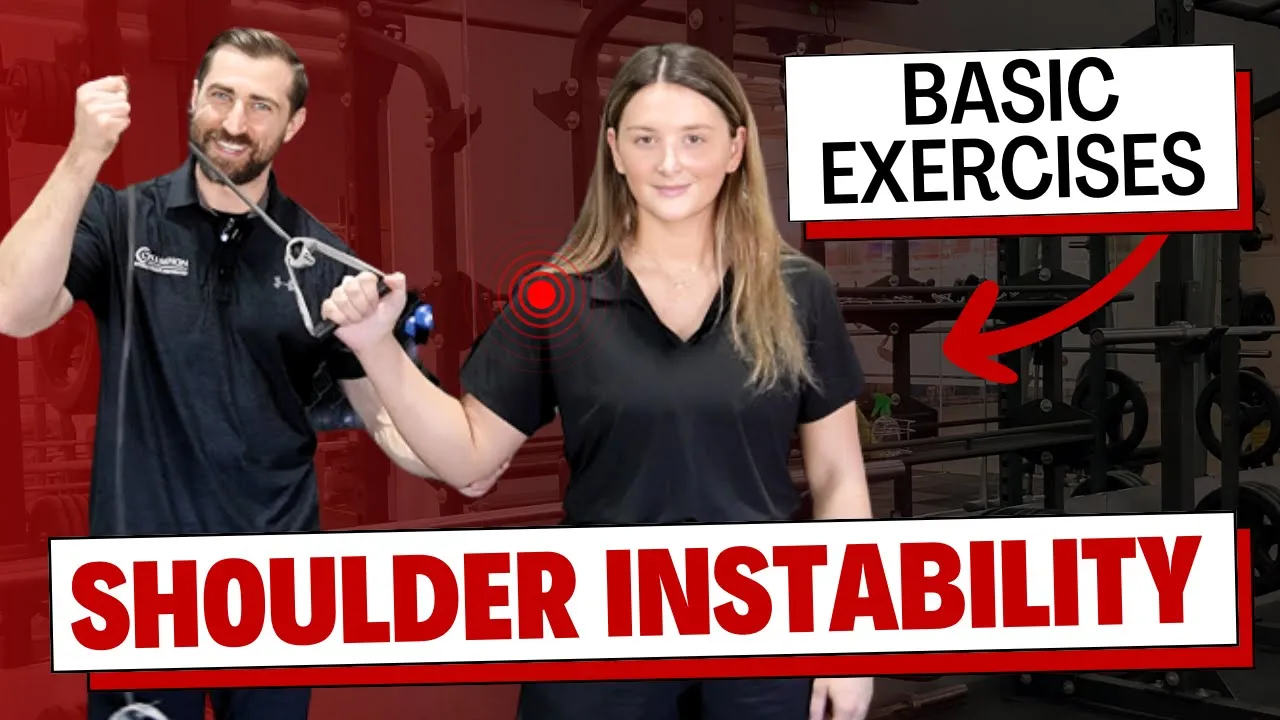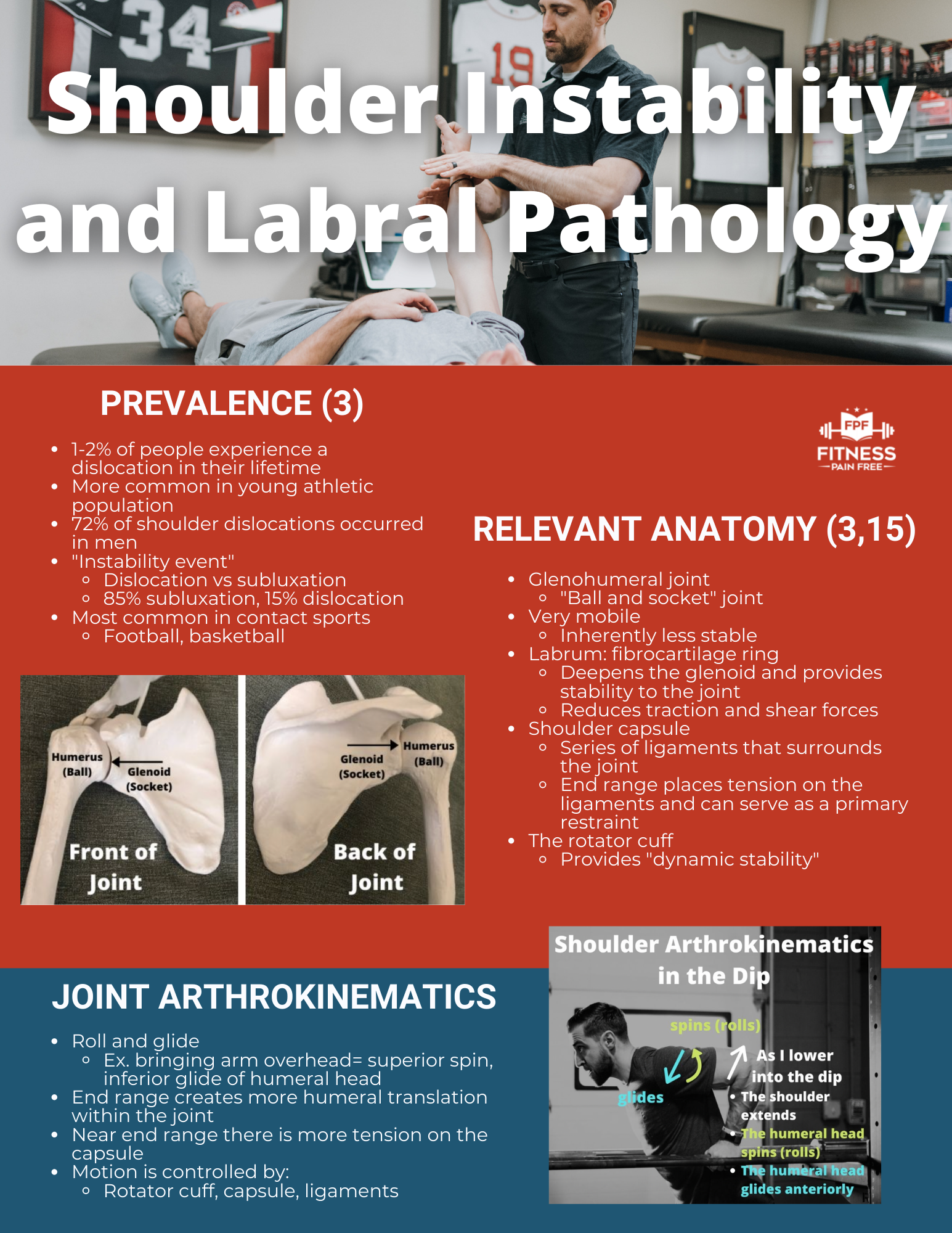
Shoulder Instability Exercise Basics [5 Keys for Physical Therapists]
To go along with today's episode I have a nice infographic to share...
Sign up to receive FREE: Shoulder Instability and Labral Pathology - The Evidence Based Cheat Sheet
Click HERE to Download FREE
Grab the rest of the Mini Course and Sign up for the Certification Pre-sale list:
- FPF Mini Course - 7 Reasons Why Injuries Happen in the Gym and What to do About it
- The Fitness Pain Free Certification
In today's video we go over Shoulder Instability Exercise Basics [5 Keys for Physical Therapists]:
Struggling with shoulder instability examination? This video is for you! Physical therapists see a lot of shoulder instability, and knowing the right exercises is key to getting your patients back to their activities. This video will cover the essential principles for exercise selection and demonstrate key exercises for both anterior and posterior instability. The first step is to identify the direction of instability.
We'll discuss how joint kinematics (movement patterns) influence this. Exercises will focus on:
- Strengthening the rotator cuff muscles, which stabilize the shoulder joint.
- Targeting specific muscles based on the type of instability (anterior or posterior).
- Utilizing closed-chain exercises (think planks and push-ups) for added stability.
- Progressing to compound movements (like rows and presses) as tolerated.
- Incorporating proprioception exercises to improve joint awareness.
Timeline:
- 0:00 - Intro
- 0:10 - Know the Direction of Instability
- 1:26 - The Importance of the Rotator Cuff
- 4:55 - Focus on Closed Chain Exercises Early On
- 10:06 - Promote Compound Exercises
- 16:32 - Challenge Shoulder Proprioception
- 21:29 - Conclusion
Feels like an earthquake is going off inside of my shoulder...
- Dan Pope DPT,OCS,CSCS
Show Notes / Relevant Articles:
- FPF Mini Course - 7 Reasons Why Injuries Happen in the Gym and What to do About it
- Anterior Shoulder Instability Clinical Examination [Physical Therapist Guide to Diagnosis]
- What Physical Therapists Need to Know About SLAP Tears
- What Physical Therapists Need to Know about Shoulder Instability
- 6 Keys to Shoulder Instability Physical Therapy
- Shoulder Instability Physical Therapy Exercises | Labral Tear, SLAP, Bankart | Open Chain
Want to support me and decide topics for future episodes? Click HERE to sign up for FPF "Insiders" for just a dollar. You'll gain access to 100+ webinars, e-books and complete guides. Plus, you'll get private access to the "Insiders" Facebook group where you can have all of your questions answered by me.
Looking for other ways to support me that are 100% free?
- Like, comment and share on youtube, facebook and instagram
- Leave a 5-star review on apple podcasts
Thank you!
Dan Pope DPT, OCS, CSCS
References:
Varacallo M, Musto MA, Mair SD. Anterior Shoulder Instability. 2023 Aug 4. In: StatPearls [Internet]. Treasure Island (FL): StatPearls Publishing; 2024 Jan–. PMID: 30855822.
Wilk KE, Macrina LC, Reinold MM. Non-operative rehabilitation for traumatic and atraumatic glenohumeral instability. N Am J Sports Phys Ther. 2006 Feb;1(1):16-31. PMID: 21522197; PMCID: PMC2953282.
Owens BD, Duffey ML, Nelson BJ, DeBerardino TM, Taylor DC, Mountcastle SB. The incidence and characteristics of shoulder instability at the United States Military Academy. Am J Sports Med. 2007 Jul;35(7):1168-73. doi: 10.1177/0363546506295179. PMID: 17581976.
Kawasaki T, Ota C, Urayama S, Maki N, Nagayama M, Kaketa T, Takazawa Y, Kaneko K. Incidence of and risk factors for traumatic anterior shoulder dislocation: an epidemiologic study in high-school rugby players. J Shoulder Elbow Surg. 2014 Nov;23(11):1624-30. doi: 10.1016/j.jse.2014.05.007. Epub 2014 Jul 10. PMID: 25017313.
Rawal A, Eckers F, Lee OSH, Hochreiter B, Wang KK, Ek ET. Current Evidence Regarding Shoulder Instability in the Paediatric and Adolescent Population. J Clin Med. 2024 Jan 26;13(3):724. doi: 10.3390/jcm13030724. PMID: 38337418; PMCID: PMC10856087.
Novakofski KD, Melugin HP, Leland DP, Bernard CD, Krych AJ, Camp CL. Nonoperative management of anterior shoulder instability can result in high rates of recurrent instability and pain at long-term follow-up. J Shoulder Elbow Surg. 2022 Feb;31(2):352-358. doi: 10.1016/j.jse.2021.07.016. Epub 2021 Aug 25. PMID: 34454036.
Leland DP, Bernard CD, Keyt LK, Krych AJ, Dahm DL, Sanchez-Sotelo J, Camp CL. An Age-Based Approach to Anterior Shoulder Instability in Patients Under 40 Years Old: Analysis of a US Population. Am J Sports Med. 2020 Jan;48(1):56-62. doi: 10.1177/0363546519886861. Epub 2019 Nov 22. PMID: 31756127.
Duethman NC, Bernard CD, Leland D, Wilbur RR, Krych AJ, Dahm DL, Barlow JD, Camp CL. Multiple Instability Events at Initial Presentation Are the Major Predictor of Failure of Nonoperative Treatment for Anterior Shoulder Instability. Arthroscopy. 2021 Aug;37(8):2432-2439. doi: 10.1016/j.arthro.2021.03.047. Epub 2021 Mar 31. PMID: 33812027; PMCID: PMC8985112.
Lee J, Woodmass JM, Bernard CD, Leland DP, Keyt LK, Krych AJ, Dahm DL, Camp CL. Nonoperative Management of Posterior Shoulder Instability: What Are the Long-Term Clinical Outcomes? Clin J Sport Med. 2022 Mar 1;32(2):e116-e120. doi: 10.1097/JSM.0000000000000907. PMID: 33852434.

